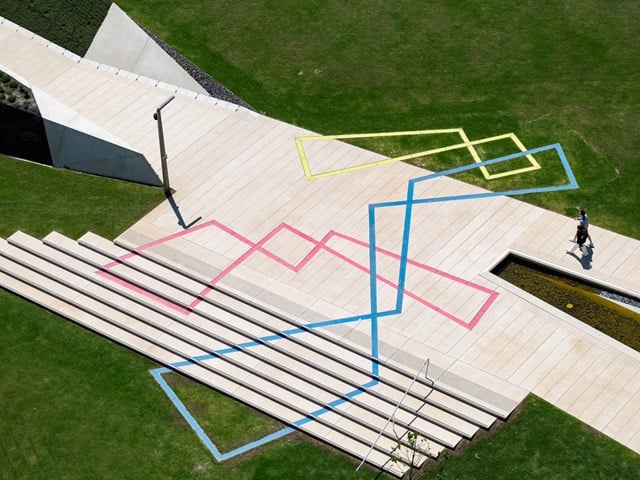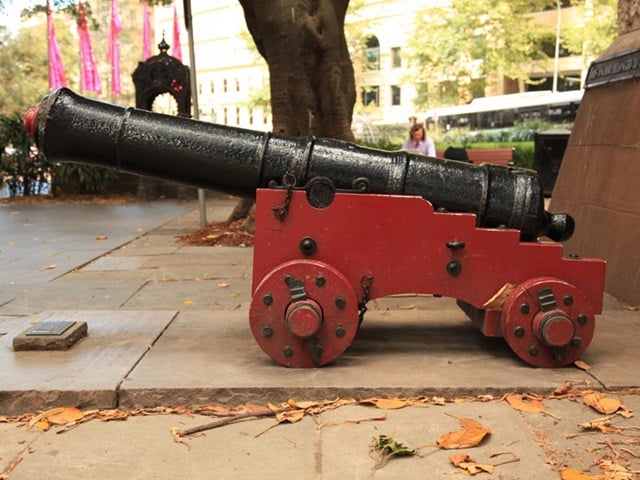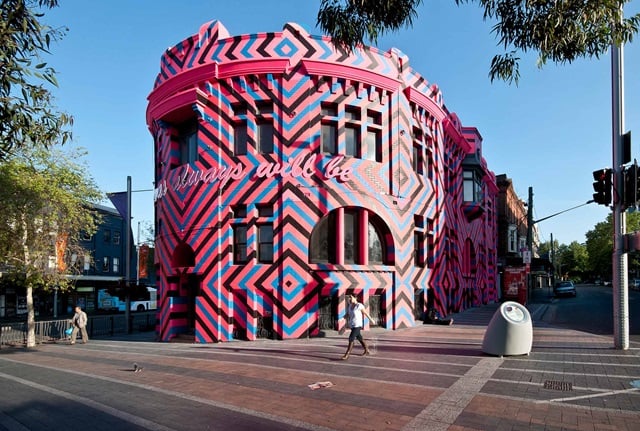
An inflatable donut with a pattern derived from traditional Wiradjuri design was suspended over the colonial architecture of Bridge Lane.
Curator: Amanda Sharrad, Justine Topfer
Artwork description
Donut was a large inflatable PVC sculpture with a black and white matrix design on its surface. The artwork was suspended one storey above Bridge Lane by wires fixed to the walls of the buildings on either side of the laneway.
The graphic style of the artwork’s surface was derived from a traditional Wiradjuri design, which the artist often uses in his work. The artwork’s silhouette was intended to present a familiar form in an unfamiliar context. Transformed into a striking, black and white, hard-edged object, Donut encouraged viewers to imagine an everyday object in a different light.
The spherical form of the artwork is referenced in many cultures. In European and Indigenous cultures it is an ancient religious design used to depict time travel and healing. Israeli physicist Amos Ori designed a time machine in the same shape and the form also echoes the circular branches of Aboriginal magic trees.
In using the donut shape the artist also brings to mind contemporary pop-culture, a ‘pie in the sky’, something unattainable yet delicious.
Andrew specifically chose Bridge Lane for his artwork because of the laneway’s colonial architecture and its history as the site of a convict lumber yard. The artist used his Wiradjuri heritage to remind viewers of the darker side of colonial history, in particular the treatment of Aboriginal and Torres Strait Islander peoples and convicts.
The artist’s goal with this work was to challenge cultural and historical perceptions and to comment on both local and global issues regarding race.
Artist
Brook Andrew’s interdisciplinary art practice is driven by the collisions of intertwined narratives, often emerging from the mess of the ‘Colonial Wuba (hole)’. His practice is grounded in his perspective as a Wiradjuri and Ngunnawal Indigenous person of Australia.
Brook’s artworks, museum interventions, research, leadership roles and curatorial projects challenge the limitations imposed by power structures, historical amnesia and complicity to centre and support Indigenous ways of knowing and being through systemic change and yindyamarra (respect, honour, go slow and responsibility).
Brook presents his artwork in Australia and internationally, with research-based museum and public space interventions, and Wiradjuri language being central to his practice.
Brook’s museum interventions began in 1996 with Dispersed Treasures at the Royal Albert Memorial Museum, Exeter. The use of Wiradjuri language began shortly after, evident in early works such as Ngaiuu Ngaay Nginduugirr (I see you) (1998), an installation combining photographic print and neon text. In 2017 Brook’s artistic career was recognised with a large-scale, immersive solo exhibition – Brook Andrew: The Right to Offend is Sacred at the National Gallery of Victoria, Melbourne.
Brook was the artistic director of the Aboriginal and Torres Strait Islander and artist-led NIRIN: the 22nd Biennale of Sydney in 2020.







